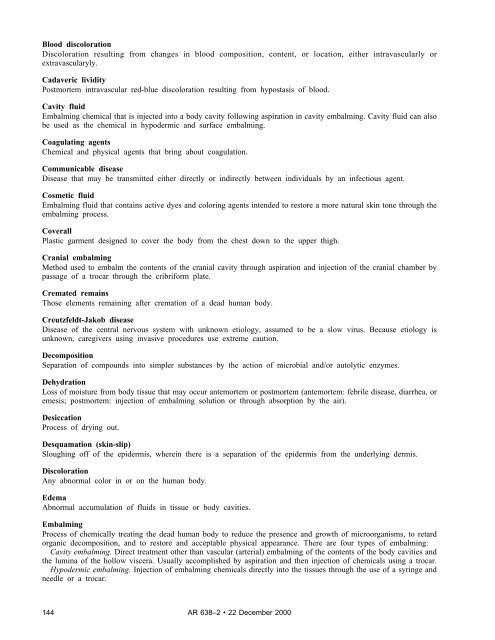Care and Disposition of Remains - Army Publishing Directorate ...
Care and Disposition of Remains - Army Publishing Directorate ...
Care and Disposition of Remains - Army Publishing Directorate ...
Create successful ePaper yourself
Turn your PDF publications into a flip-book with our unique Google optimized e-Paper software.
Blood discoloration<br />
D i s c o l o r a t i o n r e s u l t i n g f r o m c h a n g e s i n b l o o d c o m p o s i t i o n , c o n t e n t , o r l o c a t i o n , e i t h e r i n t r a v a s c u l a r l y o r<br />
extravascularyly.<br />
Cadaveric lividity<br />
Postmortem intravascular red-blue discoloration resulting from hypostasis <strong>of</strong> blood.<br />
Cavity fluid<br />
Embalming chemical that is injected into a body cavity following aspiration in cavity embalming. Cavity fluid can also<br />
be used as the chemical in hypodermic <strong>and</strong> surface embalming.<br />
Coagulating agents<br />
Chemical <strong>and</strong> physical agents that bring about coagulation.<br />
Communicable disease<br />
Disease that may be transmitted either directly or indirectly between individuals by an infectious agent.<br />
Cosmetic fluid<br />
Embalming fluid that contains active dyes <strong>and</strong> coloring agents intended to restore a more natural skin tone through the<br />
embalming process.<br />
Coverall<br />
Plastic garment designed to cover the body from the chest down to the upper thigh.<br />
Cranial embalming<br />
Method used to embalm the contents <strong>of</strong> the cranial cavity through aspiration <strong>and</strong> injection <strong>of</strong> the cranial chamber by<br />
passage <strong>of</strong> a trocar through the cribriform plate.<br />
Cremated remains<br />
Those elements remaining after cremation <strong>of</strong> a dead human body.<br />
Creutzfeldt-Jakob disease<br />
Disease <strong>of</strong> the central nervous system with unknown etiology, assumed to be a slow virus. Because etiology is<br />
unknown, caregivers using invasive procedures use extreme caution.<br />
Decomposition<br />
Separation <strong>of</strong> compounds into simpler substances by the action <strong>of</strong> microbial <strong>and</strong>/or autolytic enzymes.<br />
Dehydration<br />
Loss <strong>of</strong> moisture from body tissue that may occur antemortem or postmortem (antemortem: febrile disease, diarrhea, or<br />
emesis; postmortem: injection <strong>of</strong> embalming solution or through absorption by the air).<br />
Desiccation<br />
Process <strong>of</strong> drying out.<br />
Desquamation (skin-slip)<br />
Sloughing <strong>of</strong>f <strong>of</strong> the epidermis, wherein there is a separation <strong>of</strong> the epidermis from the underlying dermis.<br />
Discoloration<br />
Any abnormal color in or on the human body.<br />
Edema<br />
Abnormal accumulation <strong>of</strong> fluids in tissue or body cavities.<br />
Embalming<br />
Process <strong>of</strong> chemically treating the dead human body to reduce the presence <strong>and</strong> growth <strong>of</strong> microorganisms, to retard<br />
organic decomposition, <strong>and</strong> to restore <strong>and</strong> acceptable physical appearance. There are four types <strong>of</strong> embalming:<br />
Cavity embalming. Direct treatment other than vascular (arterial) embalming <strong>of</strong> the contents <strong>of</strong> the body cavities <strong>and</strong><br />
the lumina <strong>of</strong> the hollow viscera. Usually accomplished by aspiration <strong>and</strong> then injection <strong>of</strong> chemicals using a trocar.<br />
Hypodermic embalming. Injection <strong>of</strong> embalming chemicals directly into the tissues through the use <strong>of</strong> a syringe <strong>and</strong><br />
needle or a trocar.<br />
144 AR 638–2 • 22 December 2000
















